Creams for local anesthesia used in dermatology, dentistry, surgery, as well as during diagnostic procedures that cause pain or discomfort. There are several pharmaceutical groups of drugs in this category. Creams intended for local anesthesia are divided into amide and ether.
A distinctive feature of these medicines is that they may contain different active components that have similar properties of blocking the sensitivity of receptors responsible for the transmission of a pain impulse from peripheral tissues to the centers brain.
The application of amide and ether anesthetics of the local spectrum of action is carried out on the surface of the mucous membrane or skin.
Record content:
- 1 Pros and cons of topical pain relief creams
- 2 Indications for use
- 3 Contraindications
- 4 Scope of cream anesthetics
-
5 Anesthetic cream groups, how local anesthetics work
- 5.1 Essential
- 5.2 Amide
-
6 The best essential remedies. Overview and application rules
- 6.1 Based on novocaine (procaine)
- 6.2 Based on benzocaine (anesthesin)
- 6.3 Based on tetracaine (ametocaine)
-
7 The best amide preparations
- 7.1 Based on lidocaine
- 7.2 Based on prilocaine
-
8 What drugs are used for local anesthesia, a list of the best
- 8.1 For cosmetic purposes
- 8.2 In surgery
- 9 Local Anesthetic Videos
Pros and cons of topical pain relief creams
Creams that are used to perform local anesthesia have positive and negative properties. The table below summarizes the main pros and cons of this category of therapeutic drugs.
| pros | Minuses |
|
|
Local anesthesia cream has many more advantages than negative properties. Especially if a person needs urgent relief of local pain syndrome. For example, for treating the surface of inflamed joints, bruises, dislocations, gum tissue, inside which the root of a diseased tooth is located.
Indications for use
Medicines in the form of a cream, which contain anesthetic components in their composition, are indicated for symptomatic use in in the following cases:
- local anesthesia before surgery, or relief of the patient's well-being during the postoperative recovery period;
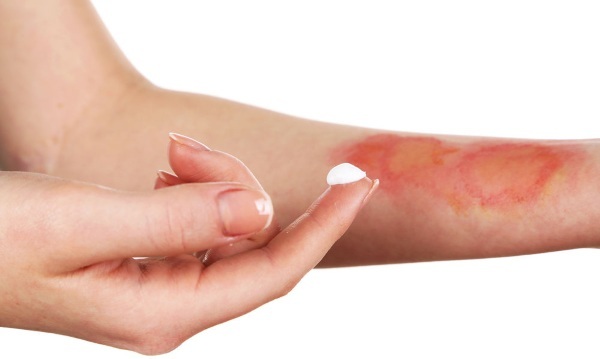
- removal of tonsils and other otolaryngological manipulations associated with the sanitation of the tissues of this part of the throat;
- all types of endoscopic and instrumental diagnostics, the conduct of which causes pain and uncomfortable sensations (anesthesia of the mucous membrane in the area of introduction of medical equipment);
- reduction of pain syndrome in inflammatory and degenerative processes in the tissues of the musculoskeletal system;
- performing dental procedures that do not involve the use of injection anesthesia.
Cream for local anesthesia is used in gynecology, obstetrics, dermatology. The main purpose of medicines in this category is to eliminate the local source of pain without the use of tablets and anesthetic solutions.
Contraindications
Most drugs for external use, which come in the form of an anesthetic cream, have the following contraindications for use:
- individual sensitivity of the patient's body to the main and auxiliary substances that make up this medication;

- tonsillectomy and adenotomy in pediatric patients under 8 years of age;
- lactation period of a newborn baby by breastfeeding (the constituent components of creams for local anesthesia can pass into breast milk).
Local anesthetic cream is used with extreme caution in patients who have the following diseases or pathological conditions of the body:
- rectoscopy in patients who have a tendency to open hemorrhoidal bleeding;
- in the area of the source of the pain syndrome, where it is necessary to apply the anesthetic cream, there are signs of infectious inflammation;
- injury to the tissues of the skin or mucous membranes;
- decreased functional activity of the liver and kidneys;
- bradycardia;
- epilepsy;
- state of shock, regardless of the reasons that provoked its occurrence;
- violation of the physiological process of cardiac conduction;
- the state of pregnancy.
Elderly patients who receive symptomatic therapy with local anesthetic creams should be under constant supervision by medical personnel. Particular attention is paid to maintaining the stable functions of the liver, kidneys, cardiovascular system.
Scope of cream anesthetics
Local anesthetic cream is a separate form of medication for treatment of skin and mucous membranes, which is used in the following branches of practical medicine:
- dermatology;
- gynecology;
- dentistry;
- proctology;
- otolaryngology;
- surgery;
- obstetrics;
- urology.
Preparations in the form of creams with analgesic properties are used to temporarily relieve pain sensations, as well as in order to facilitate the patient's well-being during the implementation of diagnostic activities.
Anesthetic cream groups, how local anesthetics work
Creams based on active substances of anesthetics are divided into ether and amide. These groups of drugs differ in chemical composition and implementation of the analgesic effect.
Essential
Essential creams with analgesic properties contain active ingredients, which are esters.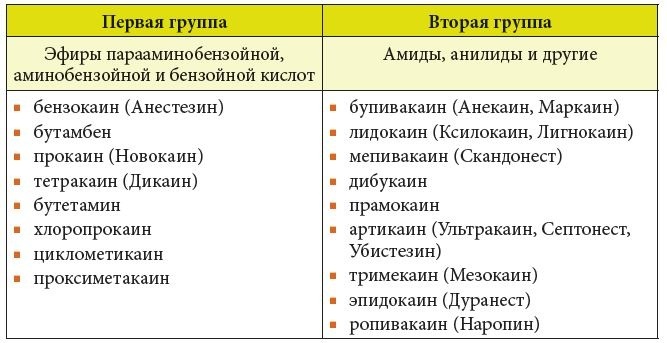
This group of anesthetics includes the following substances that act as a medicinal basis for a large number of anesthetic drugs:
- Benzocaine;
- Procaine;
- Tetracaine.
Esters dissolve well in fatty and aqueous liquids, which facilitates their unhindered passage through the membranes of all types of cells. After applying the drug based on the ester bond, its active substance quickly penetrates into the tissue site where the source of the pain syndrome is present. The anesthetic effect occurs within 3-5 minutes.
The disadvantage of ester-based anesthetic creams is that the drugs in this group undergo metabolic degradation too quickly. Within 30-50 minutes. there is a complete destruction of ester bonds, which entails the reappearance of pain.
Amide
Amide anesthetics in the form of creams for the treatment of the skin and mucous membranes are characterized by exactly the same principle of action as ether anesthetics. The constituent components of drugs in this group suppress the sensitivity of receptors and the conduction of pain impulses along peripheral nerves to the centers of the brain.
A distinctive feature of amide-based creams is their chemical formula, as well as a longer period of action. The anesthetic effect of this group of painkillers lasts from 45 to 90 minutes.
Amides include the following types of active ingredients that can be included in anesthetic creams:
- Mepivacaine;
- Articaine;
- Bimecaine;
- Trimecaine;
- Lidocaine.
Amide anesthetics are more popular, are more effective, and also provide anesthesia for a significant area of tissue. In this aspect, ester-based analgesic creams are inferior to those containing amides.
The best essential remedies. Overview and application rules
All essential anesthetic creams are applied by metered dose directly on the surface of the skin and mucous membrane in the area of pain localization syndrome.
Based on novocaine (procaine)
As a local anesthetic based on novocaine, Menovazan ointment is produced. This drug has a thick consistency, has a white color and a pleasant aroma. For all external characteristics, this tool resembles a cream for external use.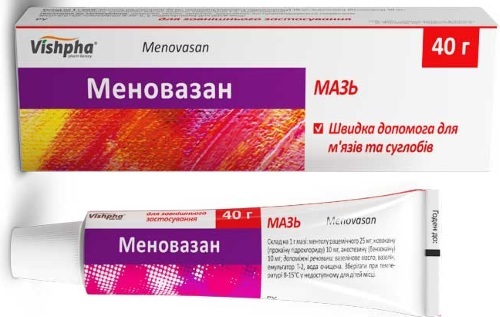
1 mg of Menovazan contains 10 mg of novocaine, 25 mg of menthol, as well as 10 mg of anestezin. The therapeutic effectiveness of this drug lies in the fact that its active ingredients not only eliminate the sensation of pain, but also have a pronounced anti-inflammatory effect.
Menovazan is applied 2-3 times a day with a uniform application of a thin layer of medication over the entire tissue area in the area of pain localization. The drug is not used for children under 12 years of age.
Based on benzocaine (anesthesin)
On the basis of benzocaine, a local anesthetic is produced in the form of anesthetic ointment. This drug contains 5% of this chemical. An auxiliary function is performed by medical petroleum jelly, which provides a better conductivity of benzocaine with its rapid penetration into the epithelial and soft tissues of the body.
Anesthetic ointment is a drug for symptomatic use. The drug is applied to the surface of the diseased area of the musculoskeletal system from 2 to 3 times a day. The medication can be used as a local anesthetic during diagnostic procedures.
Based on tetracaine (ametocaine)
The anesthetic substance tetracaine is part of the Tattooist Red topical cream. This remedy is used for cosmetic and therapeutic purposes to suppress pain in all parts of the body. The use of the drug is carried out by treating the skin with 1-2 g of cream.
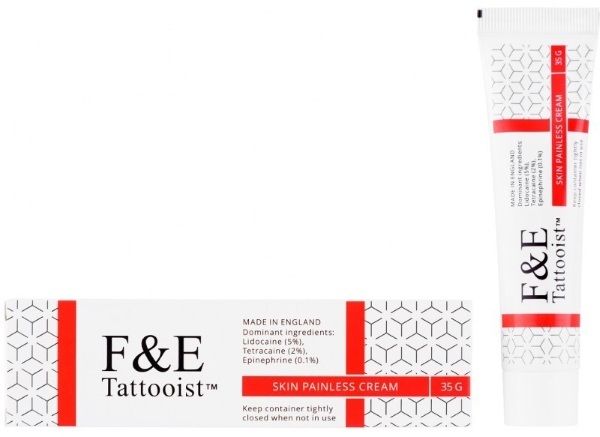
In Tattooist Red, tetracaine is present in 2% concentration. This tool is intended for symptomatic therapy at the time of the onset of acute or aching pain. The cream is applied to the surface of the skin on average 2 to 3 times a day.
The best amide preparations
Amide preparations in the form of creams and gels to achieve the effect of anesthesia are the most popular among doctors in various branches of medicine.
Based on lidocaine
One of the best drugs of the amide series, which are used for local anesthesia, is the drug Helikain. It is a colorless gel with a transparent and uniform consistency.
The dosage of this medication is 20 mg of lidocaine hydrochloride in 1 g of the drug. The application of Helikain is carried out externally with application to the surface of the skin, and also with the help of this agent, the treatment of mucous membranes is performed. The anesthetic effect occurs already after 1 min. after using this medication.
Based on prilocaine
Drug for external use Acriol Pro is a cream with an anesthetic effect, which has a combined chemical composition. The active components of this medication are the substances lidocaine and prilocaine in a dosage of 2.5 g per 100 g of the drug.
The use of this tool is carried out by applying 1-2 g of cream to the surface of the skin or mucous membrane, where pain is localized. The duration of symptomatic therapy depends on the type of underlying disease and the recommendations of the attending physician.
What drugs are used for local anesthesia, a list of the best
Drugs for external use in the form of creams, gels and ointments that have an analgesic effect are used in cosmetology purposes, before surgical intervention and in the postoperative period, as well as to eliminate pain in sprains and injuries.
For cosmetic purposes
In cosmetology, the use of creams with analgesic properties is common in salons and clinics that provide services for depilation, tattooing, and drug correction of certain parts of the body.
In this area, the following topical anesthetics are most popular:
- primary anesthesia Goochie A36 15 ml;
- Tattooist Red 35 ml;
- Mark EcoPharm 10 ml;
- Eye Anesthetic Cream 10 ml;
- cream-balm Healer Cosmetics 10 ml.
The use of the above drugs allows you to get rid of pain of moderate intensity, eliminate the feeling of discomfort, the appearance of which is associated with the performance of cosmetological manipulations. The use of these funds is carried out before starting the procedures with a cosmetologist, as well as during the recovery period after visiting this specialist.
In surgery
In surgical practice, creams with analgesic properties are used in the process of carrying out simple local operations, the performance of which does not require the use of injection anesthesia.
In this case, the following effective drugs can be used:
- Luan;
- Lidocaine;
- Emla;
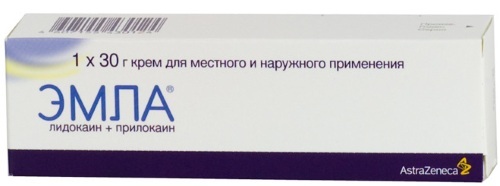
- Helikain.
The use of these drugs is possible not only before the surgical intervention, but also during the postoperative rehabilitation of the patient. For example, lubrication of the skin surface in the circumference of the surgical suture in the process of antiseptic treatment of a wound or replacement of dressings.
For medical purposes for pain relief from sprains, bruises and injuries
For anesthesia of certain parts of the body affected by bruises, sprains and other injuries, the following types of drugs are used external use based on analgesic components:
- Menovazine;
- Karipain;
- Lidocaine cream 9.6%;
- Dr. Namb;
- Menovazan;
- Honda Cream Maximum.
The appointment of the above drugs with anesthetic and anti-inflammatory effect should be carried out only a traumatologist after a diagnostic examination of a part of the body that has undergone a bruise or another type injury. Otherwise, various complications may develop.
Local anesthetic creams are drugs that are used in almost all branches of medicine, as well as for the purpose of pain relief during cosmetic procedures. Medicines are classified into amide and ether, the distinctive features of which are the duration of the anesthetic effect and the area of anesthesia.
The most common drugs for external use that are part of the pharmaco-therapeutic group of anesthetics are creams, gels and ointments based on lidocaine. The main advantage of using local anesthetics is their ease of use, the ability to treat the skin and mucous membranes.
Local Anesthetic Videos
Instructions for Lidocaine:



